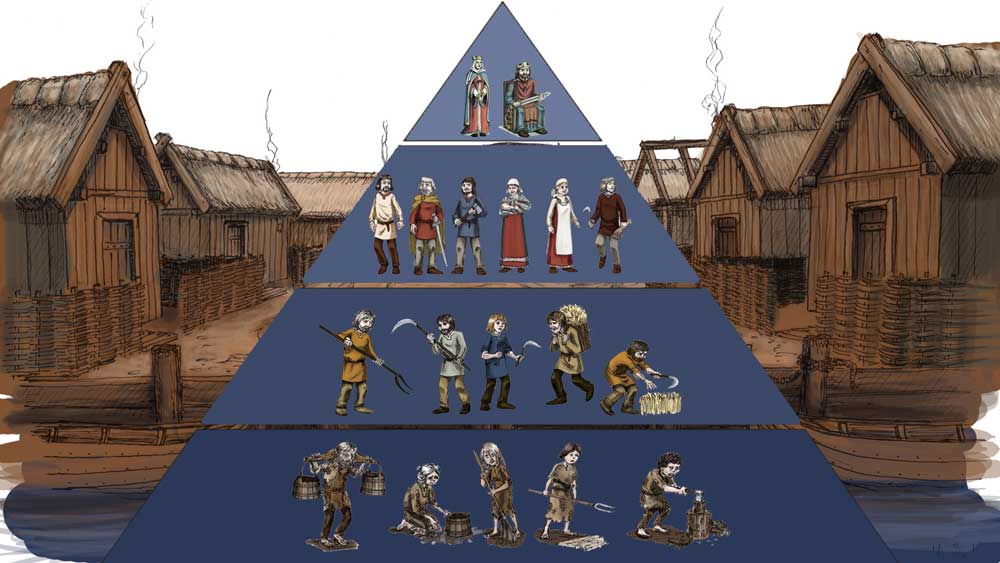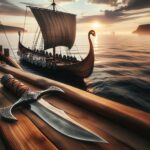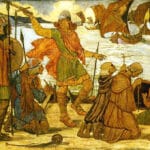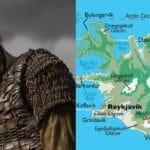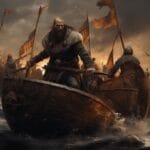The Vikings, those fierce warriors from Scandinavia, inspire awe and fascination even today. Their success in conquering lands and striking fear into the hearts of their enemies was due in part to their surprisingly sophisticated military organization. Far from the image of a chaotic horde, the Viking army operated as a well-oiled machine, with a clear chain of command and specialized roles for maximum efficiency.
Viking Army Ranks: From Thrall to Konungr
The Viking army was structured through a defined hierarchy, with each rank bearing specific responsibilities. While this structure might appear rigid, it was this very system that made them such formidable opponents. Each Viking understood their position, duties, and the importance of following their leaders. This inherent organization, combined with their ferocity and seafaring skills, enabled them to raid, trade, and conquer across Europe and beyond. Let’s break down the ranks, from the lowliest recruit to the leader of the pack:
The Bottom Rung:
- Thralls: These were the newest recruits, often conscripts, convicts working off their sentences, or even slaves hoping to earn freedom through bravery in battle. Life at the bottom was harsh, but it was a proving ground and a chance to rise through the ranks.
- Karls or Huskarls: These seasoned soldiers represented the backbone of the Viking army. Having survived numerous raids and honed their skills with an axe, they formed the bulk of the Viking fighting force. They served as mentors to the Thralls, teaching them the ways of war and sharing hard-earned wisdom.
Climbing the Ranks:
- Hirdmen: These individuals were essential in maintaining the cohesion and order of the army. They acted as intermediaries between the higher-ranking officers and the regular soldiers, ensuring orders were relayed and followed, and maintaining discipline within the ranks. They were the glue that held the army together.
Leaders of the Raid:
- Hersir: These skilled warriors served as company commanders, leading groups of Karls and Thralls into the heart of battle. Their experience and strategic thinking earned them the respect of their men, and they were instrumental in securing victory.
- Jarl: This rank represented a significant increase in power and responsibility. Jarls were regional governors or powerful chieftains who commanded the loyalty of multiple companies of Vikings. They coordinated large-scale attacks and often spearheaded expeditions far from home. They were the strategists, the masterminds behind the Viking war machine.
The Ultimate Authority:
- Hertogi or Konungr: This was the pinnacle of Viking military leadership. Hertogi were exceptional military leaders who commanded unwavering respect and loyalty from their men, while Konungr were kings who inherited their position but still needed to demonstrate their valor in battle. They bore the responsibility of making critical decisions that determined the fate of the Viking people, leading them to glorious victory or crushing defeat.
Beyond the Traditional Ranks: The Specialists
The Viking army’s success wasn’t solely based on brute strength; they recognized and utilized specialized skills to enhance their effectiveness:
- Merkismathr: This individual held a crucial and perilous position – carrying the standard, a sacred banner that served as a vital rallying point in the chaos of battle. If the standard fell, it was seen as a terrible omen, so the Merkismathr had to be exceptionally strong and unbelievably brave.
- Stallari: More than a mere advisor, the Stallari was the king’s most trusted confidante and right-hand man. This role demanded exceptional organizational and strategic thinking skills, as the Stallari was responsible for overseeing the army’s administration, mediating disputes, and ensuring the smooth operation of the entire military force.
What Was the Structure of the Viking Army?
Viking armies were structured for agility and efficiency, organized around smaller, more manageable units, often numbering around a thousand strong. This allowed for the lightning-fast raids and devastating attacks that became their hallmark. Flexibility and adaptability were paramount.
While a clear hierarchy existed, Viking society was remarkably egalitarian, especially in times of war. The “dreng,” young warriors eager to prove themselves, fought alongside the “thegn,” seasoned veterans who had earned their place through countless battles. Even those of high social standing, like the “karls” (freemen) and “jarls” (chieftains), were expected to take up arms alongside their comrades when the need arose. This reflected a deep-seated belief that leadership was earned through action, not just inherited status.
This meritocratic approach fostered a sense of unity and shared purpose. When the call to arms sounded, social distinctions blurred, and every Viking fought for the collective good. This, combined with their flexible structure, made them incredibly adaptable on the battlefield.
Who Were the Key Figures in a Viking Army – Leaders and Specialized Roles
To truly understand the dynamics of a Viking army, we need to look beyond the basic ranks and examine the roles of those who held the most influence:
The Leaders:
- Konungr (King): At the apex of the Viking power structure stood the Konungr. He led his people, commanded the armies, and set the course for their campaigns of conquest and expansion.
- Jarls: Second only to the king, Jarls were powerful regional leaders who functioned as both military commanders and political figures. They commanded the loyalty of numerous warriors, controlled vast territories, and often led expeditions far beyond Scandinavian shores.
- Hersirs: These local chieftains were the backbone of the Viking army, responsible for organizing raids, ensuring their warriors were adequately equipped, and leading them into battle with courage and cunning.
The Specialists:
- Housecarls: These elite warriors were the personal bodyguards of kings and Jarls. Highly skilled and fiercely loyal, they were sworn to protect their lords, even at the cost of their own lives.
- Merkismathr: Carrying the standard was a position of immense honor and danger. The Merkismathr served as a rallying point for the warriors, and their courage under fire could inspire victory or signal defeat.
- Stallari: Serving as the king’s right-hand man, the Stallari was a trusted advisor, strategist, and administrator. They ensured the smooth running of the army, mediated disputes, and offered counsel to the king on matters of war and peace.
These leaders and specialists, each with their own crucial roles, formed the core of the Viking military machine. Their combined efforts transformed the Viking army from a band of fierce warriors into a force capable of conquering nations and changing the course of history.
How Did the Viking Army Ranks System Influence Warfare Strategy?
The Viking army’s success stemmed not only from the ferocity of individual warriors but also from a surprisingly sophisticated system of ranks and organization. This structure allowed for a level of coordination and strategic thinking that often took their enemies by surprise.
Here’s a closer look at the key ranks and their roles in warfare:
| Rank | Description |
|---|---|
| Thralls | These were the newest recruits, often conscripted or even slaves seeking freedom through combat. While lacking experience, their numbers bolstered the ranks and provided the raw manpower necessary for the Vikings’ aggressive tactics. |
| Karls/Huskarls | The experienced veterans, hardened by battle. They formed the backbone of the army, their discipline and combat prowess crucial for maintaining formations and breaking enemy lines. |
| Hirdmen | These individuals served as essential links in the chain of command, relaying orders, maintaining discipline, and ensuring the smooth flow of information on the battlefield. |
| Hersir | As company commanders, the Hersirs translated the broader strategy into tactical maneuvers on the ground. They led their units with courage, adapting to changing conditions and exploiting enemy weaknesses. |
| Jarl | These powerful leaders commanded multiple companies, coordinating larger movements of troops and resources. Their strategic decisions often determined the overall success or failure of a campaign. |
| Hertogi/Konungr | At the top of the hierarchy, the Hertogi and Konungr provided overall leadership, setting the strategic objectives and inspiring their warriors to victory. |
The Viking Edge:
This ranking system provided the Vikings with several key advantages:
- Swift Decision-Making: The clear chain of command allowed orders to be relayed quickly and efficiently. This was essential for adapting to unexpected situations and exploiting fleeting opportunities in the heat of battle.
- Specialization: Each rank had specific duties, leading to a more efficient and deadly fighting force. From skilled swordsmen to expert archers and siege engineers, every Viking had a role to play in achieving victory.
- Motivation and Aspiration: The prospect of rising through the ranks fueled the ambition of many Viking warriors. This desire for glory and higher status translated into fierce determination and a willingness to face any challenge.
- Unified Force: The strict command structure fostered discipline and obedience within the ranks. This unity of purpose was often the deciding factor in battle, allowing the Vikings to present a cohesive and terrifying force to their enemies.
- Psychological Warfare: The very sight of a well-organized Viking army, with its banners flying and ranks arrayed in perfect order, was often enough to strike fear into the hearts of their opponents. This psychological advantage often proved just as effective as any weapon in their arsenal.
The Vikings’ military success stemmed from a combination of factors: their ferocity in battle, their mastery of shipbuilding and navigation, and their surprisingly adaptable and strategic approach to warfare. Their system of ranks, while seemingly simple, provided the organizational backbone upon which their empire was built. Uncover the identity of the most feared viking of all time, a figure shrouded in both myth and terror.
